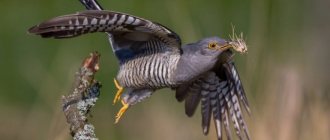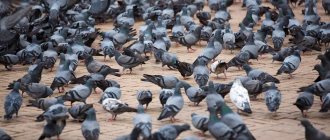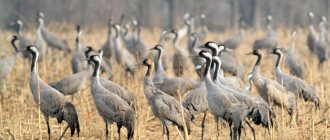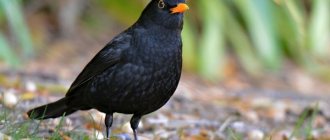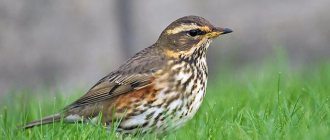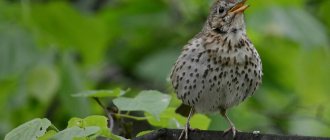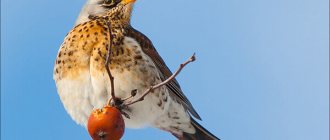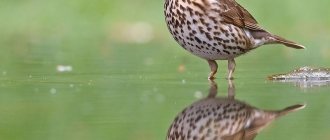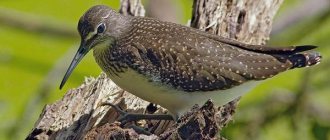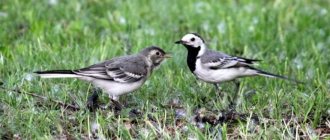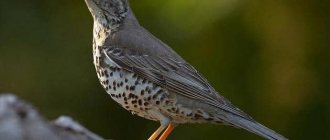What does a blackbird look like?
The appearance of the thrush also varies depending on the species, but the general characteristics remain the same. These are small, fragile birds with dense plumage, strong legs, a small flat tail and tightly pressed wings. Blackbirds can be brown and gray, black and white-collared. Blackbirds are birds with beautiful bright plumage, often with complex patterns that nature gave them. The peculiarity of these birds is their sharp, dense beak, which helps them obtain animal food, and their strong elongated legs, which help them catch up with it. Blackbirds jump quite actively with some stops. The eyes are located on the sides and have a black halo. If necessary, you have to bend over to the side to look closer at the ground. The thrush is a migratory songbird that loves to display its nightingale-like voice and sings from mid-spring to late autumn. Blackbirds fly away to warmer, more favorable climates away from harsh winters, and when the thaw sets in, they return to nest. In one season, a healthy individual is able to reproduce about 17 chicks.
The female differs from the male in size and general appearance. The male is stockier, more voluminous, he has clear, not blurry plumage and there is a defined transition between the body and head.
Fieldfare Thrush
general characteristics
Blackbirds are small birds with a body length of no more than 30 cm and a wingspan of no more than 38 cm. Based on the variety, adult blackbirds can weigh 40-150 grams.
Blackbirds have a remarkable head structure: the eyes are located on the sides of the head, which is why the birds are forced to tilt their heads to the side when searching for food.
The beak of blackbirds is quite short and is usually gray or yellow. The plumage of birds is not variegated, as a rule, it is gray with dark specks present, which are located on the body in a random order. Sometimes only blackbirds are found.
Birds' wings are not long, their ends are rounded.
The tail has 12 tail feathers. The legs are quite short, but at the same time strong; at the ends there are fused horny plates. Sexual dimorphism in birds is not pronounced: male and female have the same plumage.
Blackbird singing
Habitats
Blackbirds live all over the world from Eurasia to New Zealand, where they were introduced and quickly became established. They like to settle in spruce and mixed forests, birch groves. Currently, you can find blackbirds in parks and city squares. The birds also settled comfortably in other urban green areas. The most common species of thrush in our country is the song thrush. Indeed, by its name, it pleases with melodic singing almost all year round, excluding the winter months. America, Europe, Asia, North Africa, New Zealand. Blackbirds live throughout Russia. They reproduce well and live well in captivity.
Blackbird bird in the photo
Interesting facts about blackbirds
There are many superstitions and myths about blackbirds. Some admire their singing, others complain that they destroy the harvest. Let's look at some interesting and true facts about these birds.
- In Russia, the most numerous is the blackbird.
- In some bird species, males and females look alike. In black, gray, shama and some other species, males differ in external characteristics from females.
- During their migration to and from their wintering grounds, blackbirds stop to eat in the fields. It happens that a flock of birds devastates an entire medium-sized field.
- Most blackbirds have blue eggs.
- Birds try to build nests in places that are well lit by the sun. They avoid dark dense forests.
- The largest representatives of blackbirds weigh up to 125 g.
- In rare cases, blackbirds can catch prey in flight, but mostly feed from the ground.
- Some species of blackbirds build nests on the ground in dense grass where they can be easily reached by predators.
- Ornithologists have found that 200 years ago blackbirds were completely wild and lived only in forests.
- Sometimes blackbirds build nests in completely unexpected places, for example, in an old metal bucket.
- Thrushes play an important role in the propagation of rowan, viburnum, hawthorn, and rose hips. Fruit seeds that came out with bird droppings germinate very well in the ground.
- Blackbirds, unlike songbirds, sing in a minor key, their songs are quieter and sadder.
- Fieldfare thrushes settled in Greenland about 100 years ago. A small flock of birds accidentally flew there and quickly spread across the island.
- Blackbirds are active dispersers of mistletoe seeds. Birds eat their berries, and then the undigested seeds end up on tree branches with droppings.
- Most blackbirds rarely drink water, as they obtain the necessary liquid from their food.
- In spring, flocks of blackbirds fly to freshly plowed fields to feed on worms and other insects.
- Under favorable living conditions, blackbirds can breed 3–4 times a year, but this happens rarely. There is a known case when a pair of blackbirds hatched 17 chicks from 4 clutches.
- Scientists have proven that blackbirds can interbreed with songbirds, but this rarely happens in the wild.
- Before flying to warmer climes, blackbirds eat a lot so that they have enough strength to get to their destination.
- Thrush chicks quickly get used to humans and become tame.
An interesting attitude towards blackbirds has developed in Italy. It is illegal to catch wild blackbirds in this country. Only ringed birds bred in nurseries can be kept as pets. But in Italy there is also a tradition of hunting blackbirds, which is not limited by any laws. It turns out that you can’t catch birds, but you can hunt them! Ancient Italian cuisine has many recipes for fried or stewed blackbird.
Blackbirds are eaten
Types of blackbirds photo and description
There are 62 species of blackbirds and they occupy almost the entire territory of the globe. We will describe some of the species in more detail. The most common species in Russia is the song thrush. It is a fairly uniform brown color with a spotted bright white belly. There are whitish spots on the wings, and the inner color of the wing is noticeable in flight. It is brownish yellow.
In Europe, the missle thrush is known for its singing talent and cheerful spotted coloration. The thrush of this ancient species is slightly larger than its predecessor. It was famous in Rus' as a hunting trophy and served at feasts. Now found in the European part of the continent. Mainly settles in city parks, oak forests and lives in close proximity to humans. Europeans have the opportunity to observe this bird very closely and take photographs with it.
Mistle Thrush
American Robin or Wandering Thrush. Looks like one of the brightest representatives of the blackbird family in America. The entire chest and abdomen are painted a bright red, fiery color. The head is black, the back and tail are gray, the legs are also gray. The inside of the tail is white. Birds inhabit the entire continent of America quite well with the exception of Alaska. This species feeds 90% on animal feed. Loves butterflies, ground beetles and other insects.
Photo of American Robin
A very beautiful plumage of the island thrush or changeable as it is also called. The name comes from the fact that the color of this bird varies depending on the species of Island Blackbird, and there are about 6 of them. And each species has its own appearance. The most beautiful plumage is the white head and completely black camouflage below. It looks very impressive. This species has spread in North America to Alaska, and the Island Thrush also lives in Europe and Russia.
Changeable Thrush
But the Blackbird is the most common bird of the thrush family throughout the population. It is completely black with an orange beak. It has many subspecies and is very common in European countries. The bird settles, without hesitation, very close to humans. It builds nests in close proximity, thereby perceiving the person in a very friendly manner. The blackbird is an omnivorous bird. Like her predecessor, she prefers animal food. Loves plant foods in the form of berries, herbs, and some fruits. Builds nests in full view of humans. They are quite dense. Nesting occurs, like other species, from April to August. With a clutch of approximately 7 eggs.
Photo of blackbird
Reproduction and raising of offspring
Blackbirds, having prepared their nests for the mating season, begin to court the females. Song thrushes attract attention with their sonorous songs. When males compete, they open their tails, fluff out their feathers, and walk with their heads held high. When meeting a female, the blackbird opens its beak and spreads its tail to gain her attention. The mating trills of birds are heard from April to June.
During the nesting period, female blackbirds can lay up to 5 eggs, which the females incubate for two weeks. The eggs are variegated in color. When favorable conditions occur, females can lay up to two clutches per season.
The first clutch begins in late April-early May. Re-laying occurs at the end of June-beginning of July.
The eggs are incubated primarily by the female. The male does not engage in food production, as a result of which the females have to leave on their own to find food. The males are busy guarding the nest, as they are not far from the egg laying and the female. When an enemy approaches, the male raises the alarm, warning of the appearance of predators or people.
Caring for chicks
After two weeks of incubation, newborn chicks are born. Blackbirds carry egg shells and throw them out of the nest. The female remains in the nest for a long time to warm the babies, then both parents begin to forage for food.
Parents need to fly out of the nest more than 200 times a day to find the required number of insects, larvae and berries to feed their offspring.
The chicks grow in the nest for 13 days. After the 15th day, they try to fly out on their own, but by this time the chicks are still too small to feed on their own. This time is considered one of the most dangerous periods in the life of chicks, since it is at this moment that most of the young individuals die.
If a nest with chicks is disturbed ahead of time, frightened chicks may crawl out of there prematurely and begin to hide in the grass. In such situations, chicks often die due to hypothermia. If people approach babies, they tend to hide and take a motionless pose in order to camouflage themselves as much as possible.
Parents feed the chicks for another 7 days. After this, already at the end of May, adult individuals begin building a new nest to organize a new clutch.
Poll: Have you ever seen blackbirds live?
Yes, I saw it
89.47%
No, I've never seen it
10.53%
Voted: 38
What do blackbirds eat?
The blackbird is a fairly omnivorous bird. The diet consists mainly of what is within reach. If these are hot areas with an abundance of animal food, then the thrush’s diet will be appropriate. These are mostly insects. The blackbird loves caterpillars, ground beetles, small beetles and worms. Nutritious animal food energizes the thrush and keeps it strong longer. Vegetable food is also no less loved by the thrush. These include berries, grass, fruits, young greens. The blackbird adapts to its habitat and feeds in accordance with natural data. In winter, during the cold season, things with food are much more modest and the blackbird is forced to be content with rowan, hawthorn and rose hips. In captivity, the blackbird feeds almost the same. It is true that due to favorable living conditions and the absence of hunger, life expectancy increases significantly.
Photo of blackbird
Nutrition
In the summer, birds feed on insects , but can also eat various invertebrates. When the berries ripen, most thrush species give preference to berries and fruit plants. For rural regions, these birds are a real disaster, as they can destroy large crops. When birds unite in flocks they can destroy:
- strawberry fields;
- pear and apple trees;
- other berry crops.
Despite such problems with the harvest, thrushes still provide benefits by destroying many agricultural insect pests.
Many people keep thrushes in their homes, but before doing this, you should know that the birds are very suspicious and shy. If you want to have this species in your home, then you need to create a spacious enclosure for it. When it is not possible to make an aviary, you need to select a cage with a minimum size of 70x30x40 cm . The aviary or cage should be equipped with hanging feeders; this is how the thrush prefers to eat food. The bird loves sunlight and water treatments. During the warm season, it is recommended to keep blackbirds at home in a well-ventilated area in partial shade.
Thrushes are voracious, but they are easier to keep than other insectivorous birds. It will take a lot of food to feed them. Birds generally prefer soft food. In addition to many types of berries, thrushes readily feed on slugs, earthworms, and naked caterpillars.
Nesting
Nesting begins in April and lasts quite a long time. The blackbird population recovers due to repeated laying of eggs during the season. The female incubates them. Building the nest is the work of both parents. And they build nests from long rods, coated with clay, which makes the nest environmentally friendly and durable. Thrushes usually place their nests on stumps, low trees, or even on the ground, in the grass. The female lays up to 7 eggs per clutch. They are light blue with brown spots. The blackbirds hatch after 14-16 days, very small and fledgling, of course. Due to excellent nutrition, acute hunger very soon subsides, and the chicks become more mature. Thick plumage appears and a desire to explore everything around. Parents obtain food for their chicks together. Small frogs and lizards. Beetles and larvae, on animal food, chicks grow much faster and become strong and active. Thrushes can eat a whole small frog or lizard, although such a meal will last for a long time. The chicks will remain under the care of their parents for about another month. The female and male take turns incubating the eggs, and they also take turns caring for the offspring and building a home. It must be said that blackbirds create a pair for one season. The chicks hatch and fly away.
blackbird nest
Lifestyle and behavioral characteristics
Blackbirds have a rather complex character, which is reflected in their restless behavior. When birds are in danger, they begin to make loud sounds to notify their relatives. This often happens in situations where blackbirds fly far from their position.
Blackbirds are considered migratory birds, since most of these birds go to warmer regions for the winter. They are considered extremely heat-loving, so they need comfortable conditions for wintering.
If blackbirds decide to return to their habitat on their own, alone, ornithologists note that the birds may get lost and fall behind the flock. However, this phenomenon is quite rare; as a rule, blackbirds are good at finding natural habitats.
In order to find food, birds have to move along the surface of the earth using frequent jumps, between which there are long pauses. After wintering, blackbirds return to their nesting site, both together with a flock and individually. If there is enough food, the birds can delay their departure for some time.
When returning home in spring, blackbirds begin to build nests, which are located on stumps or trees. If there are no permanently resident predators on the territory, nests can be built directly on the ground.
How long do blackbirds live?
Blackbirds live in their natural habitat from 5-17 years. It all depends on the degree of favorable conditions. If there is enough food, warmth and fellow birds, then the blackbird can live for more than a decade and a half. If the conditions of the natural environment are unsatisfactory, then for a number of different reasons the thrush can significantly reduce the quality and life span. Blackbirds live longer in captivity. The duration can reach 20 years. You can calmly, as practice shows, take a blackbird from its nest and feed it at home. Due to the fact that these birds are quite small and modest in size, they need careful and constant care, which, unfortunately, they sometimes cannot provide for themselves. A person can easily provide a thrush with a minimum set of conditions for the longevity of thrushes. Which contributes to the harmonious reproduction of thrushes in captivity.
Photo of a wandering blackbird
Natural enemies
Blackbirds have many enemies in nature. Their nests are destroyed by crows, magpies, jays, and small predators. Adult birds are hunted by owls, peregrine falcons, and hawks.
When strangers attack a nest, blackbirds always try to protect the offspring. Males usually begin to scream and warn neighbors of danger. Birds living in groups attack predators all together. In extreme cases, blackbirds begin to shower the enemy with droppings, which stick together his feathers or fur.
Since blackbirds love to peck the fruits of cherries, cherries, strawberries and strawberries, people try to get rid of them, and sometimes even shoot these useful birds. This negatively affects bird populations.
HELPFUL INFORMATION. To prevent blackbirds from ruining your garden, it is better to purchase a special repeller that imitates the calls of birds of prey. This will help preserve both the crop and the blackbirds.
How blackbirds sing
It must be said that a unique feature of these birds is their voice! It is often recorded on audio as relaxing sounds. The voice of a thrush, especially males, is similar to the trills of a nightingale. The overflows and rolls are reminiscent of the sounds of a flute and pipe. A variety of melodies and tunes can be heard in the morning and evening from this bird. The voice of the blackbird can be heard in the park and city square, because the blackbird has long become a city friend. Although the bird prefers to nest in forests and copses, it still flies with pleasure into the urban area and lives next to humans. She takes food from him and sings her wonderful melodies as a sign of gratitude.
Photo of a song thrush
When do blackbirds fly to Russia?
Seeing when the blackbirds arrive is difficult. As during the migration period, birds gather in small groups and move at night. During the day, birds are in search of food to accumulate strength for the flight. They may appear at the end of March, if weather conditions permit.
Important! By gathering in flocks, birds can cause great damage to gardens and vegetable gardens. Most often, problems with birds occur in populated areas that are located near forests.
Where do they settle in the forest?
In forest conditions, thrushes settle in trees and tall bushes. However, nests can often be seen in old stumps, hollows and even in the ground. The bird's nest is arranged in such a way that it is well protected from predatory animals. Twigs and moss are used for construction.
Place of settlement of birds
In the city
In urban conditions, it is difficult to notice whether blackbirds fly away for the winter or not, since they are practically not found in megacities. The blackbird is a voracious species and settles in places with plenty of food. Within the city it can be found in park areas and forest plantations.
Important! Birds rarely settle in the city, as they have limited access to food and are often attacked by predators that destroy their nests.
When the chicks are hatched
The thrush can hatch chicks twice a season. Birds fly to their permanent nesting site in April, so the female hatches her first clutch in May. The second incubation occurs in mid-summer.
Why blackbirds are useful
The world's bird population is of great importance. They interact with nature, performing their immediate tasks. Namely, thrushes are involved in the reproduction of the species, the reproduction of many plants and the degradation of the number of harmful insects. It is impossible to select any fragment separately. These tasks are completed and the birds cope sufficiently with all the tasks assigned to them. Everything that nature provides is significantly important for maintaining the balance of the fauna. Man, as a thinking individual, is obliged to promote natural balance. Bring harmonious adjustments and support the animal and plant world. Often a person is forced to observe the opposite picture. Quite a lot of organizations support the bird population and expand its species diversity.
Come to us
Listen to a blackbird sing
The audio tag is not supported by your browser. Close
Where to find blackbird
If you want to get a song thrush, remember that young birds are not suitable for this. It is necessary to look for an adult bird. You need to catch it in the spring in March-April before nesting begins. Thrushes should be lured with various delicacies: mealworms, ant eggs. When they start flying regularly, you need to set a trap. It can be made from a plastic bottle with the neck cut off. It is placed on the ground and covered with earth, and bait is placed inside. Once the bird gets into the bottle, it will no longer be able to get out due to the slippery walls and narrow space.
When catching a thrush, you need to remember that wild birds can be infected with parasites. After the thrush gets used to its owner a little, you should definitely show it to the veterinarian.
Sometimes people pick up an injured blackbird, care for it and treat it. After this, the bird can no longer be released into the wild, as it has forgotten how to look for food for itself.
HELPFUL INFORMATION. Some cities have rehabilitation centers for blackbirds. If you find an injured bird, it is recommended that you take it there.
Lifespan and relationships with other animals
Thrushes can hardly be called long-lived among birds, but some species and individual individuals actually live for quite a long period, as for small birds.
The average lifespan of these birds is from five to twenty years. The beautiful and vocal song thrush lives about fourteen years, but if kept in a cage, then only twelve. The White-browed Thrush lives to be nineteen years old, and the aforementioned Fieldfare Thrush lives to be eighteen.
Surprisingly enough, these friendly birds have a whole list of enemies and predators that hunt them. Most often these are larger carnivorous birds: crows, hawks, owls, besides them also woodpeckers and jays. These enemy organisms go on a real hunt for thrush eggs, unfeathered chicks, and even for those who have already crawled out of the nest, but have not learned to fly.
But not only various birds become a threat to thrushes. Even seemingly peaceful squirrels and hedgehogs create a constant level of threat for these birds. What can we say about martens or numerous snakes, domestic cats and dogs. They all love to destroy thrush nests, looking for eggs and young chicks. In addition, adult individuals are also not always completely safe; they are attacked by peregrine falcons and hobby falcons, as well as other huge birds of prey.
When the moment of danger comes, adult thrushes behave extremely courageously and are ready to do anything to protect their offspring and home. First of all, males create a lot of noise and scary screams, which scare away some predators, but not all. Some thrush species live in communities, in which case the protection of nests is carried out jointly.
These birds have an interesting method of defense - dropping droppings on enemies, which glues the feathers of predators together. Quite often, these birds help smaller birds (finches, flycatchers) protect their property from squirrels and other small creatures.
